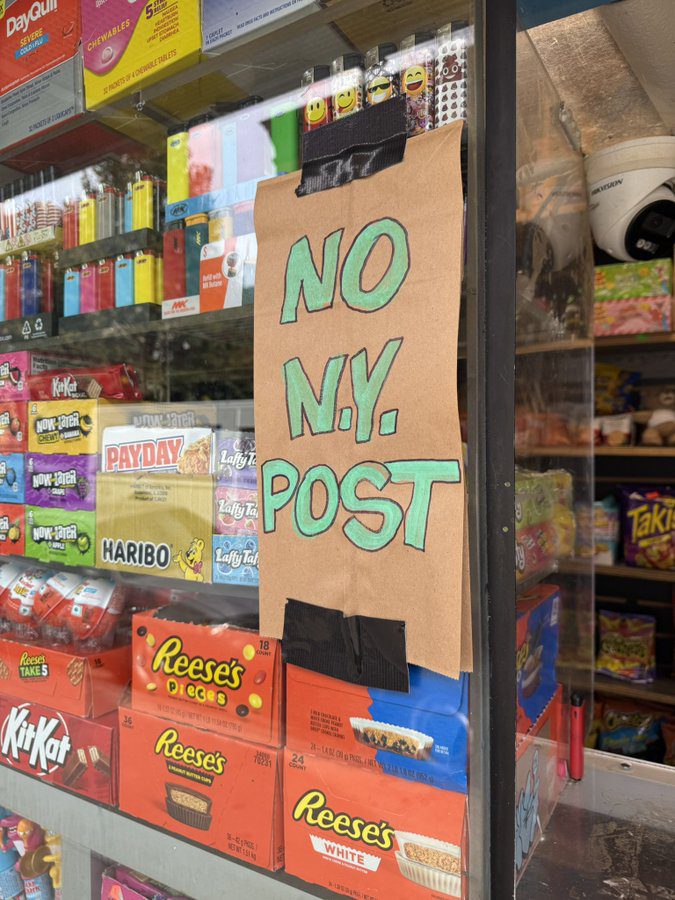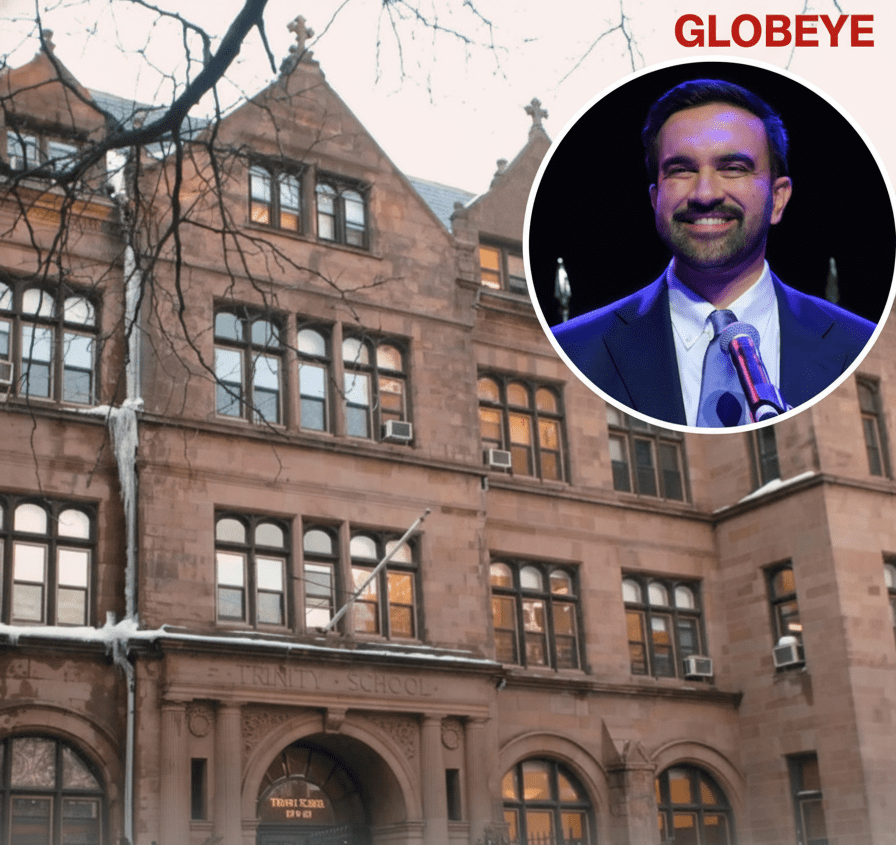New York Post’s “Red Apple” Cover on Mayor-Elect Zohran Mamdani Becomes an Overnight Collector’s Item After Selling Out Across the City and Reappearing on eBay for 20 Times Its Price
In a city that’s seen it all, few front pages have ever caused a commotion quite like this one. The New York Post’s November 5 edition — featuring the now-famous “Red Apple” headline and a striking image of Mayor-elect Zohran Mamdani surrounded by Soviet-style artwork — sold out within hours of hitting newsstands across New York City. By noon, dozens of shops were taped with handwritten “No N.Y. Post” signs. By mid-afternoon, copies were already being flipped on eBay for up to $25 each, making the newspaper itself part of the story it was telling.

The cover, headlined “THE RED APPLE,” paired with the cheeky tagline “On your Marx, get set, Zo!” quickly went viral online. It was bold, provocative, and instantly polarizing — a reflection of the city’s divided response to Mamdani’s historic win as the first openly socialist mayor in modern New York history. The Post’s signature tabloid flair, which often draws both praise and outrage, had once again turned a political moment into a cultural spectacle.
According to the New York Post’s own report, the issue sold out in multiple boroughs within hours of publication. One Manhattan vendor said customers were lined up before dawn, while another in Queens said he had never seen demand like it. “People were buying five, six copies at once,” one Harlem newsstand worker told the paper. “By 10 a.m., I was completely out.” Across Brooklyn, handwritten cardboard signs reading “No NY Post” began appearing in store windows as collectors raced to snag the now-iconic cover.
But the frenzy didn’t end there. On eBay, sellers began listing copies for as much as $25 each — nearly twenty times the original $2.50 price tag. One reseller reportedly sold two dozen copies for $14.25 apiece before 3 p.m. Wednesday. Others were bundling copies into “collector packs,” complete with plastic sleeves and rigid backing, mimicking the way rare comic books or baseball cards are sold. For media historians, the rush was both nostalgic and telling: in an age where print newspapers are supposed to be fading, one front page had suddenly become one of the most sought-after items in New York.
The irony wasn’t lost on anyone. A paper that often skewers socialism was now the subject of capitalist frenzy — its editions being flipped for profit faster than concert tickets. “It’s the most New York thing ever,” one social media user joked. “A socialist mayor elected — and his face becomes a $25 collectible overnight.” Others were less amused, accusing the Post of sensationalism for using Cold War imagery and a hammer-and-sickle motif to depict Mamdani’s victory. Still, whether viewed as satire, art, or insult, the cover had achieved what few headlines do in 2025: it made print feel alive again.
For Zohran Mamdani, the attention underscored the scale of his historic rise. The 34-year-old lawmaker from Queens, who once described himself as a “Democratic Socialist with an immigrant’s heart,” had gone from community organizer to mayor-elect of America’s largest city. His campaign, focused on affordable housing, public transit reform, and working-class empowerment, resonated with voters exhausted by decades of establishment politics. Supporters celebrated his win as a “changing of the guard,” while critics warned of what they called “an experiment in economic naivety.”
The Post’s cover captured that tension perfectly — or perhaps deliberately amplified it. Designed in classic tabloid fashion, it merged humor with provocation, turning Mamdani’s win into both a headline and a lightning rod. By late Wednesday, photos of the cover flooded social media feeds worldwide, drawing millions of views on X (formerly Twitter) and Instagram. Memes sprang up comparing the cover to Cold War propaganda posters, while others praised it as “instant pop culture gold.”
Collectors weren’t the only ones cashing in. According to the New York Post’s own store site, orders for back issues skyrocketed, forcing the company to restock the edition online. It’s rare for a daily newspaper to generate such commercial buzz — rarer still for it to happen in real time. “It’s one of those moments where print feels like an event again,” said one journalism professor at NYU. “This wasn’t just about the story; it was about owning a piece of it.”
Meanwhile, the resale surge sparked debates about value — both economic and symbolic. To some, paying $25 for a tabloid cover felt absurd; to others, it was a small price for a physical slice of New York history. In an age of fleeting digital headlines, holding a tangible copy carried meaning. “It’s not about politics,” one buyer wrote on eBay. “It’s about capturing a moment in time — the night New York changed.”
Behind the spectacle, though, lay an undeniable cultural shift. Mamdani’s victory represented a new kind of leadership in a city long dominated by establishment figures and centrist Democrats. His promises of rent freezes, wealth taxes, and city-run grocery programs marked one of the boldest policy shifts in decades. Whether loved or loathed, his win symbolized a growing appetite for change — one that reached beyond campaign speeches and into the streets themselves. The sold-out cover became a visual shorthand for that transformation.
For New Yorkers, the episode felt like déjà vu from another era — when newspapers were more than just conveyors of news; they were conversation starters, cultural anchors, and, occasionally, collector’s items. The last time the Post saw this kind of frenzy was during Donald Trump’s 2016 election and the Yankees’ 2009 World Series win. But this was different. This was about ideology — and identity. The “Red Apple” edition had turned the morning paper into a political Rorschach test: part satire, part symbol, part snapshot of a city in transition.
In a statement, the New York Post acknowledged the wild demand, confirming that copies were being resold online and hinting that future reprints might be made available for collectors. “It’s always exciting to see our readers so engaged,” an editor said. “That’s what great journalism — and great front pages — are supposed to do: capture attention and spark conversation.”
As night fell over Manhattan, the buzz refused to fade. Outside newsstands in Times Square and Union Square, tourists asked clerks if they had “the Mamdani issue.” They didn’t. In the Bronx, one small store owner taped his final copy to the wall behind the counter, saying he’d “never seen anything like it” in 20 years of selling papers. And online, the frenzy continued — listings multiplied, bids rose, and New Yorkers laughed at the irony that a socialist mayor’s face was suddenly fueling a small-scale capitalist boom.
For Mamdani, who spent the day in meetings preparing for his transition to office, the moment reportedly came as a surprise. He has not commented on the resale chaos, though his aides have called it “an amusing reflection of New York’s personality — always passionate, always unpredictable.”
What happens next is anyone’s guess. The Post will likely lean into the phenomenon with reprints or commemorative posters. Collectors will keep flipping copies. And for the rest of the city, the cover will stand as a visual bookmark — the day New York elected a mayor whose campaign was built on economic justice, and whose face, ironically, became the center of a capitalist feeding frenzy.
A day after the election, the city’s pulse is still racing. “The Red Apple” may have started as a cheeky headline, but it has already entered the lore of New York media — part journalism, part art, and entirely unforgettable.



